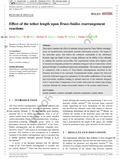Effect of the tether length upon Truce‐Smiles rearrangement reactions

Metadata
Show full item recordAuthor
Fuss, David
Wu, Yu Qi
Grossi, Michael R.
Hollett, Joshua W.
Wood, Tabitha E.
Date
2017-07-07Doi
10.1002/poc.3742Citation
Fuss, David, Yu Qi Wu, Michael R. Grossi, Joshua W. Hollett, and Tabitha E. Wood. “Effect of the tether length upon Truce-Smiles rearrangement reactions.” Journal of Physical Organic Chemistry 31 (1) (January 2018), e3742 [published online 7 July 2017]. https://doi.org/10.1002/poc.3742.
Abstract
This report examines the effect of substrate design upon the Truce‐Smiles rearrangement, an intramolecular nucleophilic aromatic substitution reaction. The length of the molecular spacer that tethers the carbanion nucleophile to the substituted benzene ring was found to have a strong influence on the ability of the substrate to undergo the reaction successfully. Our experimental results show highest yield of desired aryl migration product for substrates designed with a 3‐atom tether, which proceed through a 5‐membered spirocyclic intermediate. The results are interpreted in comparison with a survey of Truce‐Smiles rearrangements described in the literature and found to be consistent. Computational studies support the observed reactivity trend and suggest an explanation of a favorable combination of ring strain and electrostatic repulsion leading to optimal reactivity of the substrate designed with a 3‐atom tether. Comparison of our results with trends for related ring‐closing reactions illustrate the unique electrostatic features of the system studied herein.
